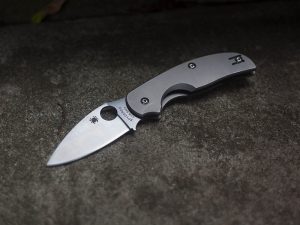
Myth 1: Some Knives don’t need to be sharpened
Some manufacturers give absurd claims that their knives do not need to be sharpened. On the surface, it sounds great, but it is only a slight resemblance to the actuality. Their claims are based on the fact that all their knives are serrated, which means even when they get dull, they can still rip instead of cutting cleanly. If you want the best performance from your knife, like when it was new, then you should sharpen your knife once in a while. Otherwise, while they will still be able to be used, they will not cut the same way as when they were right out of the box.
Myth 2: A Sharp Knife is safer than a dull one
This myth does have some logic behind it; however, it still does not hold true. When you get injured by a knife, it means you got cut buy it in some form or another. Thinking like this would say that knife that does not cut well is less likely to injure the user. The problem with this thinking is that dull knives require more force to complete the cutting action, which in turn makes the user more likely to lose control and accidentally injure themselves because the knife went somewhere it should not have gone.
Myth 3: Harder Blades Stay Sharp Longer
While hardness is a factor in how sharp an edge a blade can hold, there is a thing as a blade being too hard. The problem is that blades that are only hard also are brittle and hence prone to breaking. Brittle blades can easily chip, losing their original edge and so become jagged and dull. If your blade will last longer, then it needs to be resilient. Hardness alone is not enough.
Myth 4: Giving a Knife as a Gift Severs Relationships
This is one of the oldest and dumbest knife myths that are still around. The idea behind this thinking is that because a knife is a cutting implement, giving one to someone means that the giver is “cutting” the ties that bind people (them) together. There is no grain of truth to this myth; It is a perfect example of the kind of magical thinking that symbols can have a direct effect in the real world.
Myth 5: Stainless steel does not rust or stain
This is a widespread misunderstanding among people in general, not just the knife fanatics. Stainless steel is more resistant to corrosion other irons that have more carbon, but despite its name, stainless steel is not 100 percent rust or stain-proof. Stainless steel like any other metal must still be adequately cared for to prevent corrosion, especially after exposure to water.
Myth 6: A higher price always means a better knife
This is false not only in regards but with many other products and services in the market. In general, a more expensive knife will you are getting a better knife, but that is not always going to happen. For example, people say that S30V steel is better than its recent revision, S35VN but according to the knife properties that is just not true. Also, there are always knives that provide you with excellent value while still being affordable (like the Boker Kalashnikov) and function similarly to more expensive knives.
Myth 7: No sparks means no sharpening
This myth probably stems from seeing people sharpen their knives on the classic grinder. Yes, sparks fly when someone is grinding out nicks on a damaged blade, but that does not mean it is a requirement for knife sharpeners to shoot out sparks. In fact, it can be a considered a bad sign as flashes are a sure sign of blade damage. Each spark that flies out of the sharpener represents a tiny fraction of the blade being ground away and the heat produced can also take the temper off the steel.
Myth 8: A knife ain’t nothing against a gun
Don’t be so sure about that, especially when you’re talking about a knife’s capabilities! Mythbusters did a segment on this exact myth. The concept behind the legend, In Adam Savage’s words, is that if your rival brings a knife to a gun fight, you have nothing to worry about because your gun is going to win. However, they found out that a knife is a very decent weapon when it comes to fighting in close range. From their testing, they discovered that a knife to be a useful tool if you are within 16 feet of your opponent.
Myth 9: A dull knife has a worn away edge
Contrary to popular belief, when a knife “loses its edge,” the tip has not worn away but folded onto itself. This is because the edge is not as defining as you might think but instead this occurs at the microscopic level.
Myth 10: Knives Are Dulled by Food, Not Cutting Boards
The idea behind this myth is that since knives are cutting through the food, it is what dulls them. While it might sound logical, this is not true. The cutting board is what stops the knife after the slice, and a hardboard can prove far more damaging to the knife than any food. Plastics boards are the best, while hard acrylic and stone are most likely to damage the blade. Wood is useful for reducing the damage to knife edges, but it can be difficult to sterilize. One way to think about it is to consider the scoring seen on a wide variety of cutting boards. If the board is not marked, all your energy that would have gone into scoring the board goes back into the edge, hence dulling the knife. This is one of the reasons granite cutting boards should be reserved for decoration rather than for actual use.

Leave a Reply